英语的前缀和后缀(新东方培训内部绝密资料)
- 格式:doc
- 大小:36.50 KB
- 文档页数:7
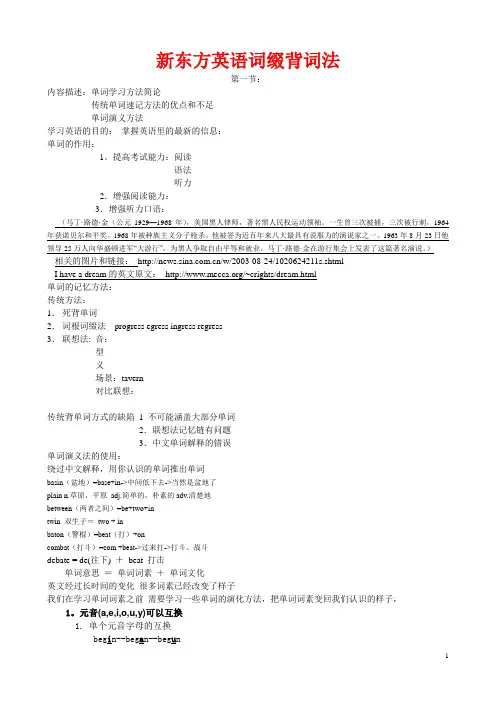
新东方英语词缀背词法第一节:内容描述:单词学习方法简论传统单词速记方法的优点和不足单词演义方法学习英语的目的:掌握英语里的最新的信息:单词的作用:1。
提高考试能力:阅读语法听力2.增强阅读能力:3.增强听力口语:(马丁·路德·金(公元1929—1968年),美国黑人律师,著名黑人民权运动领袖。
一生曾三次被捕,三次被行刺,1964年获诺贝尔和平奖。
1968年被种族主义分子枪杀。
他被誉为近百年来八大最具有说服力的演说家之一。
1963年8月23日他领导25万人向华盛顿进军―大游行‖,为黑人争取自由平等和就业。
马丁·路德·金在游行集会上发表了这篇著名演说。
)相关的图片和链接:/w/2003-08-24/1020624211s.shtmlI have a dream的英文原文:/~crights/dream.html单词的记忆方法:传统方法:1.死背单词2.词根词缀法progress egress ingress regress3.联想法: 音:型义场景:tavern对比联想:传统背单词方式的缺陷 1 不可能涵盖大部分单词2.联想法记忆链有问题3.中文单词解释的错误单词演义法的使用:绕过中文解释,用你认识的单词推出单词basin(盆地)=base+in->中间低下去->当然是盆地了plain n.草原,平原adj.简单的,朴素的adv.清楚地between(两者之间)=be+two+intwin 双生子=two + inbaton(警棍)=beat(打)+oncombat(打斗)=com +beat->过来打->打斗、战斗debate = de(往下) +beat 打击单词意思=单词词素+单词文化英文经过长时间的变化很多词素已经改变了样子我们在学习单词词素之前需要学习一些单词的演化方法,把单词词素变回我们认识的样子,1。
元音(a,e,i,o,u,y)可以互换1. 单个元音字母的互换beg i n--beg a n--beg u nap e rture 裂缝 = ap a rt +ture2. 元音字母组合的互换s ea t--s i t--s a tbaton = beat + on 鼓棒、指挥棒、权杖、警棍combat = com + beat 战斗3. 元辅字母组合的互换flower = florid 像花一样的Florence 花之城佛罗伦萨Flora 花神2. 辅音字母的转化stand - sdand t- dspin - sbin p- bsky - sgy k- gcool - kool c- kdesign - dezign s- z1.c-k-g-quc--k k indle 点燃,发光 =c andleg--k stink 刺鼻的 = sting 刺g--c pi g ment 色素 =pi c t+ mentc-qu check = cheque 支票2.b-p lambent = lamp ent =发柔光的3 v--f wi f e -- wi v esbelieve - belief 信念4.t--d 啮齿动物 rodent = rat老鼠 + dent(齿轮的)齿3.形近字母的转换u - v - wu--v na u sea --- na v y+ seat =晕船v--w renovation-- re + ne w + tion=革新n—m bri n k边缘 ---bri m边缘4.音的脱落+,- h : hour arduous 费力的 + h =(h)arduouschannel 海峡、水沟= canal 运河、水道+,- g: high hyperactive 甲亢的 = hy(high)+ per + activefeign假的 = feint 假装、佯攻5.规则变换及组合变换s -d conclude结束, 终止, 决定, 作出结论推断, 断定, 缔结,议定- conclusions- t -d rat - abrade v.磨损- abrasion n.磨损f-ph--p p iscatology= =捕鱼学p yromania 放火狂b-p-f-v proveproof 证据、考验probe 探测(以证实猜想)单词演义法的使用pin penpine pineapplepoint pain ponypenal punish punchpungent词本无义义由境生bite bitbate batspine spinalspinsterfinfine finger finesse Finland (芬兰地图)Chile is a thin finger of land that .. 智利是一指之地/智利是一条细长的土地。
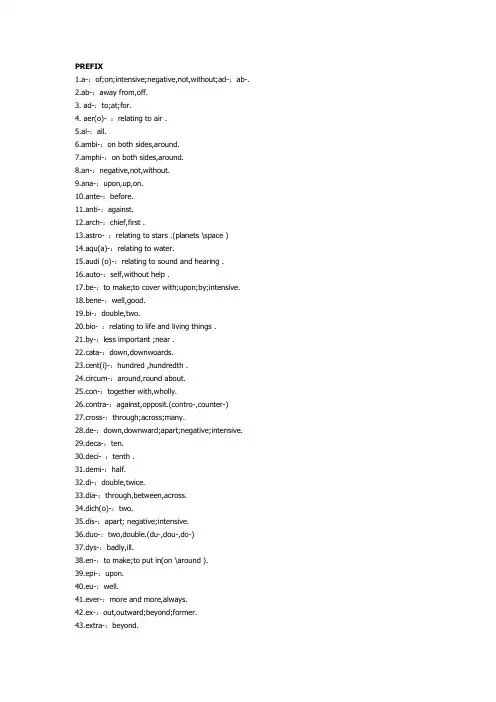
PREFIX1.a-:of;on;intensive;negative,not,without;ad-;ab-.2.ab-:away from,off.3. ad-:to;at;for.4. aer(o)- :relating to air .5.al-:all.6.ambi-:on both sides,around.7.amphi-:on both sides,around.8.an-:negative,not,without.9.ana-:upon,up,on.10.ante-:before.11.anti-:against.12.arch-:chief,first .13.astro- :relating to stars .(planets \space )14.aqu(a)-:relating to water.15.audi (o)-:relating to sound and hearing .16.auto-:self,without help .17.be-:to make;to cover with;upon;by;intensive.18.bene-:well,good.19.bi-:double,two.20.bio- :relating to life and living things .21.by-:less important ;near .22.cata-:down,downwoards.23.cent(i)-:hundred ,hundredth .24.circum-:around,round about.25.con-:together with,wholly.26.contra-:against,opposit.(contro-,counter-)27.cross-:through;across;many.28.de-:down,downward;apart;negative;intensive.29.deca-:ten.30.deci- :tenth .31.demi-:half.32.di-:double,twice.33.dia-:through,between,across.34.dich(o)-:two.35.dis-:apart; negative;intensive.36.duo-:two,double.(du-,dou-,do-)37.dys-:badly,ill.38.en-:to make;to put in(on \around ).39.epi-:upon.40.eu-:well.41.ever-:more and more,always.42.ex-:out,outward;beyond;former.43.extra-:beyond.44.for-:away from.45.fore-:before.46.forth-:towards.47.geo- :relating to earth .48.hecto-:hundred.49.hemi-:half.50.hetero-:other,different.51.hexa-:six.52.homo-:same.53.hyper-:above,beyond.54.hypo-:under.55.hydr(o)-:relating to water or hydrogen.56.in-:into;negative,not,without.57. infr(a)-:under,after.58. inter-:between,among.(enter-,intel-)59. intr-:within,inward.60. iso-:equal,same.61. kilo-:thousand.62. macro-:large,long.63. mal(e)-:badly,ill.64.matr(i)-:relating to woman.65. mega-:large,strong,million.66. meta-:above;behind;of change.67. micro-:small.68.mid- :middle .69. milli-:thousand,thousandth.70.mini-:small.71. mis-:wrong(ly),bad(ly),ill.72.mono-:single,sole,alone.73.mult(i)-:many,much.74.ne-:negative,not,without.75.neo-:new.76.non-:not.77.ob-:against;towards;intensive.78.octa-:eight,eighth.(octo-)79.omni-:all.80.out-:out,outward;beyond.[超越、胜过]81.over-:above;beyond;upside-down.[过度,颠倒]82.paleo-:ancient.83.pan(to)-:all.84.para-:like;beside;beyond; against(抗、防)85.pen-:almost.86.penta-:five.87.per-:through,thoroughly,away.88.peri-:around,round about.89.photo- :relating to light .90.poly-:many.91.post-:after,behind.92.pre-:before.93.pro-:in favor of ;in public;in place of;before, forward.94.prot(o)-:chief,first.95.pseudo-:false.96.psycho- :relating to the mind .97.quadr(i)-:four.98.qat(e)r-:four.99.quasi-:like;partly.[类似的、部分的、准的]100.quint-:five.(quinque-)101.re-:again,back.102.retr(o)-:backward.[向后、追溯、归还]103.se-:apart,away.104.semi-:half;partly.105.sept-:seven.106.sex-:six.107.step-:orphaned.[后、继]108.sub-:under.[分、支,次、亚]109.super-:above,over.(sove-,sop-,sur-)110.syn-:together,with,same.112.tele-:far away.113.tetra-:four.114.trans-:across;change.(tra-,tran-,tres-)115.tri-:three,threefold.116.twi-:two.117.ultra-:beyond.118.un-:not;the reversal of an action[相反的动作]。
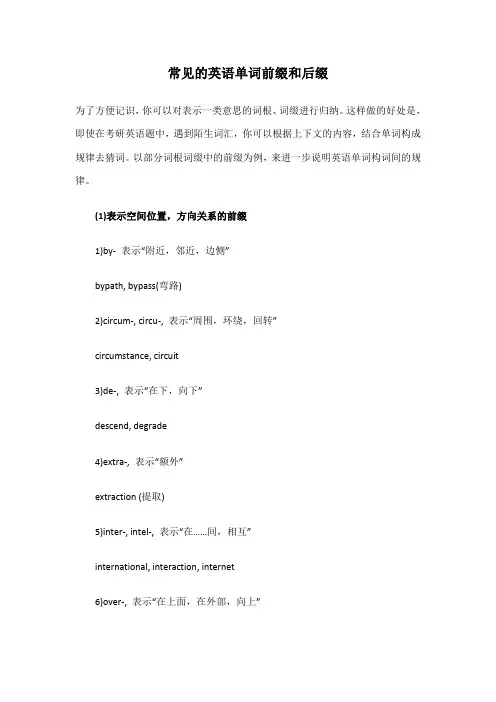
常见的英语单词前缀和后缀为了方便记识,你可以对表示一类意思的词根、词缀进行归纳。
这样做的好处是,即使在考研英语题中,遇到陌生词汇,你可以根据上下文的内容,结合单词构成规律去猜词。
以部分词根词缀中的前缀为例,来进一步说明英语单词构词间的规律。
(1)表示空间位置,方向关系的前缀1)by- 表示“附近,邻近,边侧”bypath, bypass(弯路)2)circum-, circu-, 表示“周围,环绕,回转”circumstance, circuit3)de-, 表示“在下,向下”descend, degrade4)extra-, 表示“额外”extraction (提取)5)inter-, intel-, 表示“在……间,相互”international, interaction, internet6)over-, 表示“在上面,在外部,向上”overlook, overhead, overboard7)pre-, 表示"在前”在前面”prefix, preface, preposition8)pro-, 表示“在前,向前”progress, proceed,9)sub-, suc-, suf-, sug-, sum-, sup-, sur-, sus-, 表示“在下面,下”submarine, suffix, suppress, supplement10)trans-, 表示“移上,转上,在那一边”translate, transform, transoceanic(2)表示否定意义的前缀1)纯否定前缀a-, an-, asymmetry(不对称)dis- dishonest, dislikein-, ig-, il, im, ir, incapable, inability, ignoble, impossible, immoral, illegal, irregularne-, n-, none, neither, nevernon-, noesenseun- unable, unemployment2)表示错误的意义male-, mal-, malfunction, maladjustment(失调) mis-, mistake, misleadpseudo-, pseudonym(假名), pseudoscience (3)表示时间,序列关系的前缀1)ante-, anti-, 表示“先前,早于,预先” antecedent, anticipate,2)ex-, 表示“先,故,旧”expresident, exhusband3)pre-, pri-, 表示“在前,事先,预先” preheat, prewar, prehistory4)pro-, 表示“在前,先,前”prologue(序幕),prophet(预言家)(4)表示比较程度差别关系的前缀1)by-, 表示“副,次要的”byproduct, bywork(副业)2)extra-,表示“超越,额外”extraordinary,3)hyper- 表示“超过,极度”hypersonic(超声波), hypertesion(高血压)4)out-,表示“超过,过分”outdo(超过), outbid(出价过高的人)5) sub-, suc-, sur-, 表示“低,次,副,亚” subeditor, subordinate, subtropical(亚热带)6)vice- 表示“副,次”vicepresident, vicechairman(5)表示共同,相等意思的前缀1)com-, cop-, con-, cor-, co- 表示“共同,一起”。
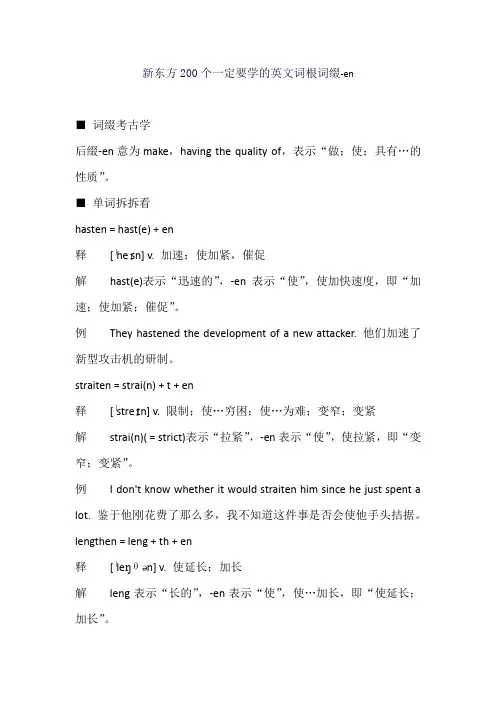
新东方200个一定要学的英文词根词缀-en■词缀考古学后缀-en意为make,having the quality of,表示“做;使;具有…的性质”。
■单词拆拆看hasten = hast(e) + en释[ˈheɪsn] v. 加速;使加紧,催促解hast(e)表示“迅速的”,-en表示“使”,使加快速度,即“加速;使加紧;催促”。
例They hastened the development of a new attacker. 他们加速了新型攻击机的研制。
straiten = strai(n) + t + en释[ˈstreɪtn] v. 限制;使…穷困;使…为难;变窄;变紧解strai(n)( = strict)表示“拉紧”,-en表示“使”,使拉紧,即“变窄;变紧”。
例I don't know whether it would straiten him since he just spent a lot. 鉴于他刚花费了那么多,我不知道这件事是否会使他手头拮据。
lengthen = leng + th + en释[ˈleŋθən] v. 使延长;加长解leng表示“长的”,-en表示“使”,使…加长,即“使延长;加长”。
例Open-air exercise undoubtedly have lengthened the old man's life. 户外运动无疑延长了老人的寿命。
■词汇拓展营darken [ˈdɑːkən] v. 变黑;使模糊sharpen [ˈʃɑːpən] v. 削尖;加重;尖锐hearten [ˈhɑːtn] v. 激励;使振作sweeten [ˈswiːtn] v. 减轻;使变甜;使温和shorten [ˈʃɔːtn] v. 缩短;减少■词根一家亲1. hast(e)(迅速的)hastily ad. 匆忙地;仓促地2. strai(n)(拉紧)constrain v. 强迫,强制3. leng(长的)lengthy a. 冗长的;乏味的。
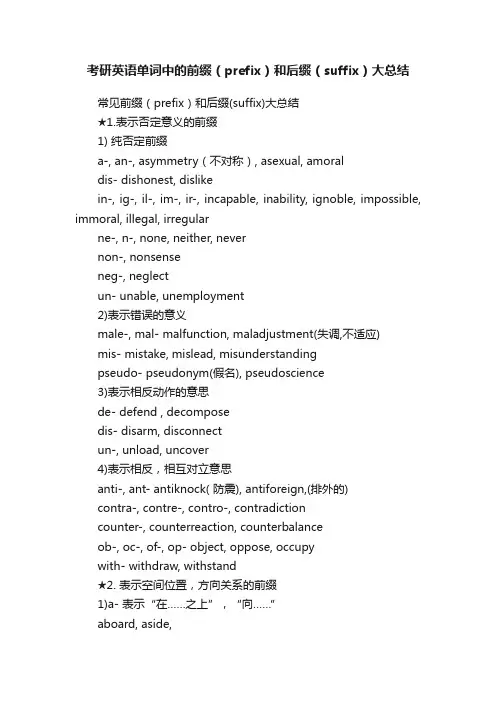
考研英语单词中的前缀(prefix)和后缀(suffix)大总结常见前缀(prefix)和后缀(suffix)大总结★1.表示否定意义的前缀1) 纯否定前缀a-, an-, asymmetry(不对称), asexual, amoraldis- dishonest, dislikein-, ig-, il-, im-, ir-, incapable, inability, ignoble, impossible, immoral, illegal, irregularne-, n-, none, neither, nevernon-, nonsenseneg-, neglectun- unable, unemployment2)表示错误的意义male-, mal- malfunction, maladjustment(失调,不适应)mis- mistake, mislead, misunderstandingpseudo- pseudonym(假名), pseudoscience3)表示相反动作的意思de- defend , decomposedis- disarm, disconnectun-, unload, uncover4)表示相反,相互对立意思anti-, ant- antiknock( 防震), antiforeign,(排外的)contra-, contre-, contro-, contradictioncounter-, counterreaction, counterbalanceob-, oc-, of-, op- object, oppose, occupywith- withdraw, withstand★2. 表示空间位置,方向关系的前缀1)a- 表示“在……之上”,“向……”aboard, aside,2)by- 表示“附近,邻近,边侧”bypath, bypass(弯路)3)circum-, circu-, 表示“周围,环绕,回转”circumstance, circus4)de-, 表示“在下,向下”descend, degrade5)en-, 表示“在内,进入”encage, encamp6)ex-, ec-, es-, 表示“外部,外”exit, expand, export7)extra-, 表示“额外”extraction (提取)8)fore- 表示“在前面”forehead, foreground9)in-, il-, im-, ir-, 表示“向内,在内,背于”inland, invade, inside, import10)inter-, intel-, 表示“在……间,相互”international, interaction, Internet11)intro-, 表示“向内,在内,内侧”introduce, introvert12)medi-, med-, mid-, 表示“中,中间”Mediterranean medieval13)out-, 表示“在上面,在外部,在外”outline, outside, outward14)over-, 表示“在上面,在外部,向上”overlook, overhead, overboard15)post-, 表示"向后,在后边,次”postscript(附言),16)pre-, 表示"在前”在前面”prefix, preface, prepositionprogress, proceed,18)sub-, suc-, suf-, sug-, sum-, sup-, sur-, sus-, 表示“在下面,下”subway, submarine, suffix, suppress, supplement19)super-, sur-, 表示“在…..之上”superficial, surface, superstructure20)trans-, 表示“移上,转上,在那一边”translate, transform, transoceanic21)under-, 表示“在…..下面,下的”underline, underground, underwater22)up-, 表示“向上,向上面,在上”upward, uphold, uphill(上坡)★3. 表示时间,序列关系的前缀1)ante-, anti-, 表示“先前,早于,预先”antecedent, anticipate,2)ex-, 表示“先,故,旧”ex-president, ex-husband3)fore-, 表示“在前面,先前,前面”foreward, forecast, foretell(预言)4)mid-, medi-, 表示“中,中间”midnight, midsummer5)post-"表示“在后,后”postwar,6)pre-, pri-, 表示“在前,事先,预先”preheat, prewar, prehistory7)pro-, 表示“在前,先,前”prologue(序幕),prophet(预言家)8)re-, 表示“再一次,重新”retell, rewrite★4. 表示比较程度差别关系的前缀byproduct, bywork(副业)2)extra-,表示“超越,额外”extraordinary,3)hyper- 表示“超过,极度”hypersonic(超声波), hypertension(高血压)4)out-,表示“超过,过分”outdo(超过), outbid(出价过高的人)5)over-,表示“超过,过度,太”overeat, overdress, oversleep6) sub-, suc-, sur-, 表示“低,次,副,亚”subeditor, subordinate, subtropical(亚热带)7)super-, sur- 表示“超过”supernature, superpower, surplus, surpass8)under-,表示“低劣,低下”undersize, undergrown, underproduction(生产不足)9)vice- 表示“副,次”vice-president, vice-chairman★5. 表示共同,相等意思的前缀1)com-, cop-, con-, cor-, co- 表示“共同,一起”。
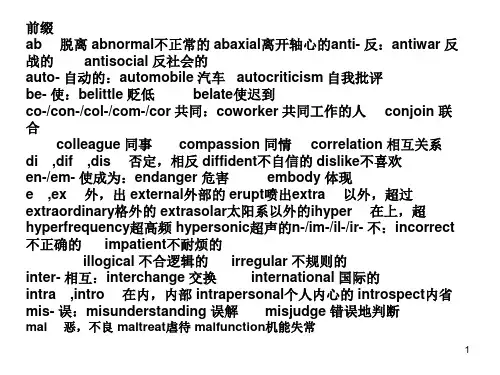
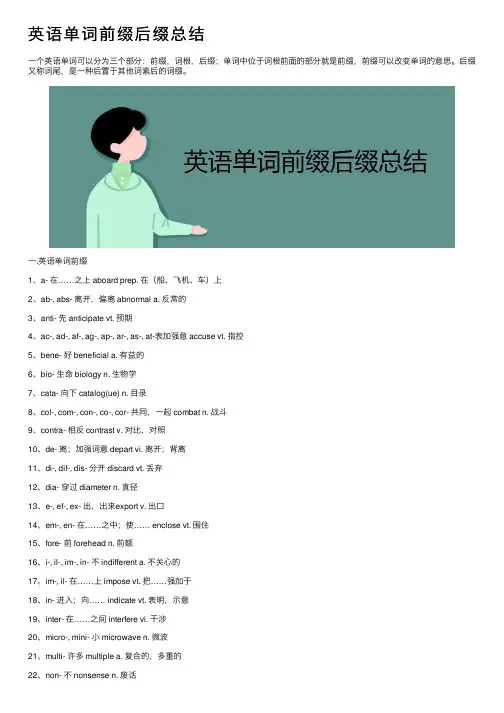
英语单词前缀后缀总结⼀个英语单词可以分为三个部分:前缀,词根,后缀;单词中位于词根前⾯的部分就是前缀,前缀可以改变单词的意思。
后缀⼜称词尾,是⼀种后置于其他词素后的词缀。
⼀.英语单词前缀1、a- 在……之上 aboard prep. 在(船、飞机、车)上2、ab-, abs- 离开,偏离 abnormal a. 反常的3、anti- 先 anticipate vt. 预期4、ac-, ad-, af-, ag-, ap-, ar-, as-, at-表加强意 accuse vt. 指控5、bene- 好 beneficial a. 有益的6、bio- ⽣命 biology n. ⽣物学7、cata- 向下 catalog(ue) n. ⽬录8、col-, com-, con-, co-, cor- 共同,⼀起 combat n. 战⽃9、contra- 相反 contrast v. 对⽐,对照10、de- 离;加强词意 depart vi. 离开;背离11、di-, dif-, dis- 分开 discard vt. 丢弃12、dia- 穿过 diameter n. 直径13、e-, ef-, ex- 出,出来export v. 出⼝14、em-, en- 在……之中;使…… enclose vt. 围住15、fore- 前 forehead n. 前额16、i-, il-, im-, in- 不 indifferent a. 不关⼼的17、im-, il- 在……上 impose vt. 把……强加于18、in- 进⼊;向…… indicate vt. 表明,⽰意19、inter- 在……之间 interfere vi. ⼲涉20、micro-, mini- ⼩ microwave n. 微波21、multi- 许多 multiple a. 复合的,多重的22、non- 不 nonsense n. 废话23、ob-, op- 相反 oppose vt. 反对24、out- 向外,出来 outlet n. 出⼝25、over- 越过 overlook vt. 忽视26、per- 穿过 perspective n. 视⾓27、pre- 在…之前 pregnant a. 怀孕的28、pro- 向前 promote vt. 促进29、re- 向后;再次 recall vt. 回忆起30、semi- 半 semiconductor n. 半导体31、sub- 在……下 subway n. 地铁32、super- 在……之上,超级的 superior a. 优于……的33、trans- 横过,越过 transplant vt. 移栽34、tri- 三 triangle n. 三⾓35、twi- 表⽰⼆、两36、un- 不 uncover vt. 揭露37、under- 在……下⾯,低于…… underline vt. 在……下⾯划线38、uni- ⼀个 unique a. 唯⼀的,独特的39、vice- 表⽰副40、with- 表⽰向后,相反⼆、英语单词后缀1、动词后缀:-ate,-en, -(i)fy, -ish, -ize/ise2、副词后缀:-ly,-ward(s), -way(s)3、形容词后缀:-able/ible,-al/ial,-full, -ic, -ish, -ive, -ly4、名词后缀:-ability,-acity,-ain,-aire,-ance,-ation,-dom,-ence,-eer,-ine,-kin5、表⽰“⼈”的名词后缀:-ist,-man, -er/or, -ee, -ant6、表⽰“⼩”的名词后缀:-el,-let, -(c)ule7、抽象名词后缀:-ion,-hood, -ic(s), -ism, -ship, -ty。
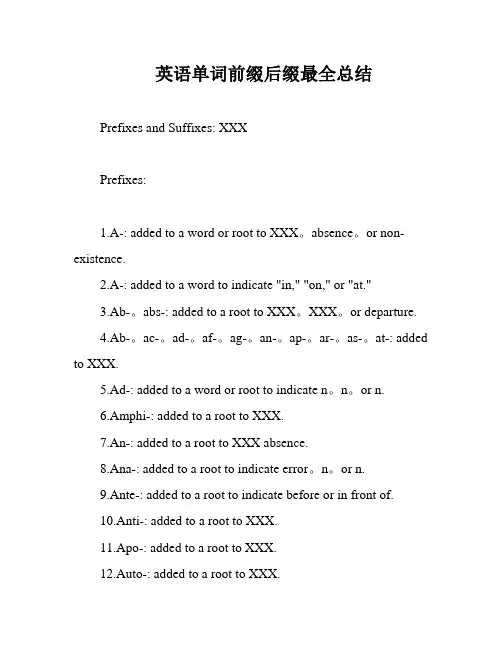
英语单词前缀后缀最全总结Prefixes and Suffixes: XXXPrefixes:1.A-: added to a word or root to XXX。
absence。
or non-existence.2.A-: added to a word to indicate "in," "on," or "at."3.Ab-。
abs-: added to a root to XXX。
XXX。
or departure.4.Ab-。
ac-。
ad-。
af-。
ag-。
an-。
ap-。
ar-。
as-。
at-: added to XXX.5.Ad-: added to a word or root to indicate n。
n。
or n.6.Amphi-: added to a root to XXX.7.An-: added to a root to XXX absence.8.Ana-: added to a root to indicate error。
n。
or n.9.Ante-: added to a root to indicate before or in front of.10.Anti-: added to a root to XXX.11.Apo-: added to a root to XXX.12.Auto-: added to a root to XXX.Suffixes:13.-Be: added to a root to form a verb indicating XXX.14.-Be: added to a root to form some ns.15.-XXX: added to a root to XXX kindness.16.-Bi: added to a root to XXX.17.-By: added to a root to XXX.18.-XXX: added to a root to indicate down。

常见的英语单词前缀和后缀为了方便记识,你可以对表示一类意思的词根、词缀进行归纳。
这样做的好处是,即使在考研英语题中,遇到陌生词汇,你可以根据上下文的内容,结合单词构成规律去猜词。
以部分词根词缀中的前缀为例,来进一步说明英语单词构词间的规律。
(1)表示空间位置,方向关系的前缀1)by- 表示“附近,邻近,边侧”bypath, bypass(弯路)2)circum-, circu-, 表示“周围,环绕,回转”circumstance, circuit3)de-, 表示“在下,向下”descend, degrade4)extra-, 表示“额外”extraction (提取)5)inter-, intel-, 表示“在……间,相互”international, interaction, internet6)over-, 表示“在上面,在外部,向上”overlook, overhead, overboard7)pre-, 表示"在前”在前面”prefix, preface, preposition8)pro-, 表示“在前,向前”progress, proceed,9)sub-, suc-, suf-, sug-, sum-, sup-, sur-, sus-, 表示“在下面,下” submarine, suffix, suppress, supplement10)trans-, 表示“移上,转上,在那一边”translate, transform, transoceanic(2)表示否定意义的前缀1)纯否定前缀a-, an-, asymmetry(不对称)dis- dishonest, dislikein-, ig-, il, im, ir, incapable, inability, ignoble, impossible, immoral, illegal, irregular ne-, n-, none, neither, nevernon-, noesenseun- unable, unemployment2)表示错误的意义male-, mal-, malfunction, maladjustment(失调) mis-, mistake, misleadpseudo-, pseudonym(假名), pseudoscience (3)表示时间,序列关系的前缀1)ante-, anti-, 表示“先前,早于,预先” antecedent, anticipate,2)ex-, 表示“先,故,旧” expresident, exhusband3)pre-, pri-, 表示“在前,事先,预先” preheat, prewar, prehistory4)pro-, 表示“在前,先,前” prologue(序幕),prophet(预言家)(4)表示比较程度差别关系的前缀1)by-, 表示“副,次要的”byproduct, bywork(副业)2)extra-,表示“超越,额外”extraordinary,3)hyper- 表示“超过,极度”hypersonic(超声波), hypertesion(高血压)4)out-,表示“超过,过分”outdo(超过), outbid(出价过高的人)5) sub-, suc-, sur-, 表示“低,次,副,亚” subeditor, subordinate, subtropical(亚热带)6)vice- 表示“副,次”vicepresident, vicechairman(5)表示共同,相等意思的前缀1)com-, cop-, con-, cor-, co- 表示“共同,一起”。
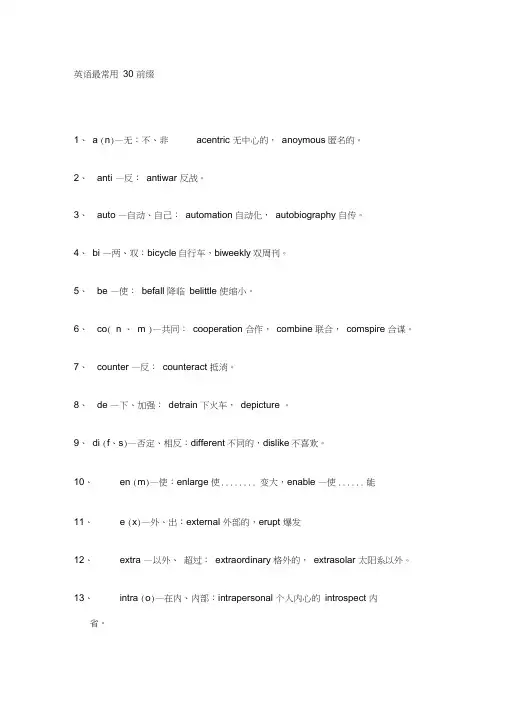
英语最常用30 前缀1、a (n)—无:不、非acentric 无中心的,anoymous匿名的。
2、anti —反:antiwar 反战。
3、auto —自动、自己:automation 自动化,autobiography 自传。
4、bi —两、双:bicycle自行车,biweekly双周刊。
5、be —使:befall 降临belittle 使缩小。
6、co( n 、m )—共同:cooperation 合作,combine 联合,comspire 合谋。
7、counter —反:counteract 抵消。
8、de —下、加强:detrain 下火车,depicture 。
9、di (f、s)—否定、相反:different不同的,dislike不喜欢。
10、en (m)—使:enlarge 使........ 变大,enable —使...... 能11、 e (x)—外、出:external 外部的,erupt 爆发12、extra —以外、超过:extraordinary 格外的,extrasolar 太阳系以外。
13、intra (o)—在内、内部:intrapersonal 个人内心的introspect 内省。
inter —在 ............... 间 in ternet 网络mi (a )cro —微小 (宏大) microsoft 微软, macrocosm 宇宙。
mini —miniskirt 迷你群。
mis —错、坏 mistake 错误。
multi —多 multiparty 多党non —否定 nonsmoker 不吸烟者。
per —贯通、遍及、完全 perfect 完美的。
pre (o )—前 preface 前言,progress 进步。
re —回、再 restart 重新开始。
sub (f )—下、后 subway 地铁,suffix 后缀。
super —超级 supertar 超级明星。
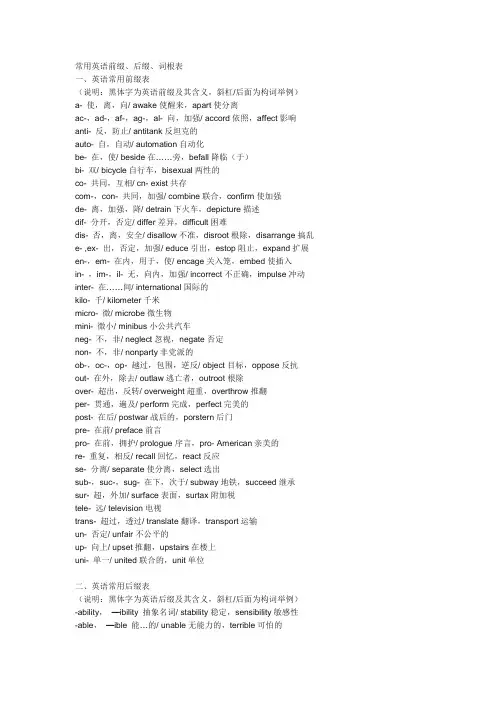
常用英语前缀、后缀、词根表一、英语常用前缀表(说明:黑体字为英语前缀及其含义,斜杠/后面为构词举例)a- 使,离,向/ awake使醒来,apart使分离ac-,ad-,af-,ag-,al- 向,加强/ accord依照,affect影响anti- 反,防止/ antitank反坦克的auto- 自,自动/ automation自动化be- 在,使/ beside在……旁,befall降临(于)bi- 双/ bicycle自行车,bisexual两性的co- 共同,互相/ cn- exist共存com-,con- 共同,加强/ combine联合,confirm使加强de- 离,加强,降/ detrain下火车,depicture描述dif- 分开,否定/ differ差异,difficult困难dis- 否,离,安全/ disallow不准,disroot根除,disarrange搞乱e- ,ex- 出,否定,加强/ educe引出,estop阻止,expand扩展en-,em- 在内,用于,使/ encage关入笼,embed使插入in- ,im-,il- 无,向内,加强/ incorrect不正确,impulse冲动inter- 在……间/ international国际的kilo- 千/ kilometer千米micro- 微/ microbe微生物mini- 微小/ minibus小公共汽车neg- 不,非/ neglect忽视,negate否定non- 不,非/ nonparty非党派的ob-,oc-,op- 越过,包围,逆反/ object目标,oppose反抗out- 在外,除去/ outlaw逃亡者,outroot根除over- 超出,反转/ overweight超重,overthrow推翻per- 贯通,遍及/ perform完成,perfect完美的post- 在后/ postwar战后的,porstern后门pre- 在前/ preface前言pro- 在前,拥护/ prologue序言,pro- American亲美的re- 重复,相反/ recall回忆,react反应se- 分离/ separate使分离,select选出sub-,suc-,sug- 在下,次于/ subway地铁,succeed继承sur- 超,外加/ surface表面,surtax附加税tele- 远/ television电视trans- 超过,透过/ translate翻译,transport运输un- 否定/ unfair不公平的up- 向上/ upset推翻,upstairs在楼上uni- 单一/ united联合的,unit单位二、英语常用后缀表(说明:黑体字为英语后缀及其含义,斜杠/后面为构词举例)-ability,—ibility 抽象名词/ stability稳定,sensibility敏感性-able,—ible 能…的/ unable无能力的,terrible可怕的-acy性质,状态/ illiteracy文盲,intricacy错综复杂-age动作,状态,总称(构成名词)/ folwage泛滥,postage邮费-al动作,行为,…的/ manual手册,central中心-an人,籍贯,…的/ African非洲的,publican旅店主-ance,—ancy行为,性质,状态/ distance距离,currency流通-ant,ent人,…的/ assistant助手,excellent优秀的-ary地点,人,事物/ library图书馆,military军事-ate做,职位,…的/ doctorate博士学位,adequate足够的-ation,-ition动作,性质,状态/ visitation访问,addition附加物-craft 技巧,工艺/ aircraft飞机,handicraft手艺-cy 形状,状态,职位/ secrecy秘密,fancy幻想-dom 状态,领域/ freedom自由,kingdom王国-ed 有…的/ cultured有教养的,puzzled迷惑的-ence,-ency 行为,性质,状态/ difference差异,frequency频率-er,—eer,—or人/ killer杀手,engineer工程师,doctor医生-ern 地点,方位/ eastern东方的,cavern洞穴-ese 人,语言,国籍/ Chinese中国人,Japanese日本人-ess 女性,雌性/ actress女演员-hood 状态,身份(构成名词)/ childhood童年,livelihood生计-ic 学术,职业,……的/ music音乐,atomic原子的-ice 人,抽象名词/ service服务,novice新手-ics 学术(构成名词)/ physics物理学,optics光学-ing 总称,抽象名词/ clothing衣服,building建筑,feeling感觉-ion 物品,抽象名词/ cushion座垫,expression表达-ism 主义,宗教/ Marxism马克思主义,Islamism伊斯兰教-ist …者(构成名词)/ communist共产主义者,dentist牙医-ive 人,物,…的/ native本地人,attractive有吸引力的-less 无…的/ homeless无家可归的,fearless无畏的-logy 学(构成名词)/ zoology动物学,biology生物学-ly …的,…地/ daily每日的,quickly迅速地-ment 状况,物,组织/ development发展,department部门-ness 抽象名词/ darkness黑暗,kindness和蔼-ous 有…的(构成形容词)/ famous著名的,dangerous危险的-ship 状况,事物(构成名词)/ friendship友谊,leadership领导能力-sion,—tion 动作,性质,状态/ expansion扩展,description描述-th 状况,第…/ youth青春,health健康,fifth第五-ty状况,…十/ specialty专业,safety安全,fifty五十-ure 状况,物(构成名词)/ pleasure快乐,picture图画-y 状况,学术,小…的/ harmony和谐,botany植物学,baby婴儿三、英语常用词根表(说明:黑体字为英语词根及其含义,斜杠/后面为构词举例)ag,act做/ agent代理人,actor演员art 技艺/ article文章bas 低的/ basic基本的bio 生命,生物/ biology生物学ced,ceed,cess走/ recede退却,proceed前进,success成功cid,cis 切/ decide决定,incise切开cit 唤起/ excite使兴奋clud,clus关闭/ include包含,conclusive最终的cord 心/ concord和睦cred,credit 相信/ credible可信的,discredit怀疑cult 耕作/ agriculture农业dic,dict 说/ indicate指出,dictator独裁者doc,doct 教/ document文件,doctor博士duc,duct 引导/ reduce减少,product产品fac,fact,fect 做/ facile易做的,factory工厂,infect传染fam 名声/ famous著名fer 带来,产生/ difference不同的,suffer经受fin 末尾/ final最后的,finish结束form 形成,组成/ reform改革,inform通知fort,forc 强/ effort努力,force力量geo 大地/ geography地理学grad,gress 脚步/ graduate毕业,progress进步gram 字符/ program节目单,telegram电报ide 外观,形式/ idea想法,ideal理想的ject 投掷/ object目标,subject主题leg,lig,lect 挑选/ elegant雅致的,eligible合格的,select选择log,logue 说话/ apologize道歉,dialogue对话mand,mend 命令/ demand要求,command命令min 较小,较少/ minute分钟,minority少数民族mit,miss 送,发/ submit呈交,dismiss解雇mot,mov,mob 运动/ remote遥远的,remove迁移,mobile移动的nat 出生/ native天生的,nature自然界nunci,nounc 讲述/ pronounce发音,enunciate宣布ord,ordin 次序/ order秩序,ordinary平常的part 部分/ apart分离,department部门pend,pens 悬挂,支付/ depend依靠,expensive昂贵的pet,petit 寻求,追求/ compete比赛,competitor竞争对手pos,posit 放置/ deposit储蓄,propose提出port 运送/ import进口,report报告reg,rect 划直线,治理/ regular正规的,correct正确的sci 知晓/ science科学,scientist科学家sent,sens 感觉/ sentence句子,nonsense废话serv 奴仆/ servant仆人,service服务sid,sess 坐/ president主席,possess占有spec,spect 看/ respect尊敬,special特别的st,stat 站立/ stay停留,station车站tain,ten,tent,tin 持有/ contain容纳,content满意,continue继续un 单一/ unit单位,united联合的ven,vent 发生,来临/ event事件,convent召集vis,vid,view 看见/ visit参观,evidence证据,review复习拉丁语名词和形容词词根原词缩略根词含义英语衍生词acerbus acerb- 苦,尖刻(bitter) 尖酸刻薄的(acerbic) acetum acet- 醋(vinegar)酸的(acetic)aedificium aedifici- 建筑(building)大厦(edifice)alacer alacr- 快(quick)敏捷(alacrity)album alb- 白(white)相册(album)alius ali- 其它(er)外侨(alien)amicus ami- 朋友(friend)亲切的(amiable)anima anim- 灵魂,生(soul, life)赋予生命(animate)annus ann- 年(year)年度(annual)aqua aqu- 水(water)水生的(aquatic)audax audac- 大胆的(brave, bold)大胆的(audacious)auris aur- 耳(ear)听觉的(aural)avis avi- 鸟(bird)鸟舍(aviary)bellum bell- 战斗(war)好斗的(bellicose)bonus– melior– optimus bon-– melior-– optim- 好(good)更好(better)最好(best)奖励(bonus)改善(ameliorate)最适宜的(optimum)bōs bov- 牛(cow)像牛一样的(bovine)canis can- 犬(dog)犬齿(canine)cervīx cervic- 颈(neck)子宫颈(cervix)cīvis civit- 公民(citizen)平民的(civilian)clāvicula clavicul- 钥匙(little key)锁骨(clavicle)coniunx coniug- 配偶(spouse)夫妇间的(conjugal)cornu corn- 角(horn)独角兽(unicorn)deus de- 神(god)神祗(deity)diēs diē- 一天(day)每日的(quotidian)discipulus discipul- 学生(student)门徒(disciple)dominus domin- 主人(lord)领土(dominion)domus dom- 房屋(house)住所(domicile)equus equ- 马(horse)骑术家(equestrian)errorem err 错误(mistake)错误的(erroneous)falx falc- 镰刀(sickle)钩状的(falcate)felinae felin- 猫(cat-like)猫科的(feline)fēmina fēmin- 女人(woman)女性的(feminine)filius fili- 子(son)孝顺的(filial)finis fini- 极限(limit)最终的(final)flos flor- 花(flower)花似的(floral)folium foli- 叶子(leaf)页码(folio)forma form- 形状(form, shape)形式(form)fors fort- 幸运(luck)偶然的(fortuitous)fortis fort- 力量(strength)坚毅(fortitude)frater fratr- 兄弟(brother)兄弟会(fraternity)frons front- 前额(forehead)前面(front)frux frug- 果实,利益(fruit)节俭的(frugal)fumus fum- 烟(smoke)烟雾(fume)genus gen- 诞生、后代(birth, offspring)世代(generation)真正的(genuine)homō homin- 人(human being) 杀人(homicide)ignis - 火(fire)引燃(ignite)insula insul- 岛(island)半岛(peninsula)心胸狭隘(insularity)iūdex iūdic- 判断(judge)公正的(judicial)判决(adjudicate)iūs iūr- 正直(right)法(law)正义(justice)司法权(jurisdiction)lachryma lachrym- 泪(tear)催人泪下(lachrymose)lex lēg- 律(law)合法的(legal)lūna lūn- 月(moon)月亮的(lunar)lupus lup- 狼(wolf)凶猛的(lupine)magister magistr- 教师(teacher)地方法官(magistrate)magnus–mājor– maximus magn-–mājor-– maxim- 大(big)更大(bigger)最大(biggest)大小(magnitude)主要(major)最大(maximum)malus mal- 坏(bad)恶意(malice)manus manu- 手(hand)手动的(manual)mare mar- 海(sea)海事的(maritime)māter mātr- 母(mother)保姆(matron)mora mor- 延迟(delay)延期偿付(moratorium)mundus mund 俗世(world)世俗的(mundane)narrat narrat- 讲述(tells)叙述者(narrator)nihil nihil- 虚无(nothing)彻底毁灭(annihilate)nox noct- 夜(night)夜的(nocturnal)oculus ocul- 眼(eye)接种(inoculate)onus oner- 负担(load)免罪(exonerate)pater patr- 父(father)保护人(patron)pavimentum paviment- 地面(ground)人行道(pavement)penis pen- 尾(tail)阴茎(penis)pes ped- 足(foot)行人的(pedestrian)pulcher pulchr- 美(beautiful)美丽(pulchritude)rex rēg- 王(king)帝王的(regal)rūs rūr- 农场(farm)乡下的(rustic)sinister sinistr- 左(left)凶恶的(sinister)terra terr- 大地(land)地形(terrain)unda und- 波(wave)起伏(undulate)urbs urb- 城市(city)市郊(suburb)Ursidae urs- 熊(bear)熊似的(ursine)vehiculum vehicul- 车(wagon)车辆(vehicle)veritas ver- 真实(truth)核实(verify)villa vill- 乡村房屋(country house)别墅(villa)村庄(village)vir vir- 男人(man)有男子气概的(virile)vulpinae vulp- 狐(fox)狡猾的(vulpine)拉丁语动词词根原词现在词根完成时词根过去完成时词根含义常见衍生词agō ag- eg- āct- 做(do)代理人(agent)行动(action)amō am- amav- amat- 爱(love)迷恋(enamor)audiō aud- audiv- audit- 听(hear)听得见的(audible)capiō-cipiō cap- cep--cip- capt--cept- 取(take)能够(capable)俘虏(captive)接受者(recipient)接待(reception)cēdō cēd- cess- 屈服(yield)离开(depart)退却(recede)超过(excess)cogitō cogit- cogitav- cogitat- 思考(think) 考虑(cogitate)colligo colligere collegi collectus 收集(collect)收集(collect)claudō-clūdō claud--clūd- claus--clūs- 关闭(close)结束(conclude)clinō clin- clinat- 靠(lean)倚靠(recline)cubō cub- cubat- 躺(lie)孵卵器(incubator)currō curr- cucurr- curs- 跑(run)流(current)循环(recursion)dō d- dat--dit- 给(give)加(add)与格(dative)doleō dol- dolui dolit- 悲伤(grieve)悲伤(dolor)哀悼(condolence)dubitō dubit- dubitav- dubitat- 质疑(doubt)不容置疑的(indubitable)faciō-ficiō fac- fec--fic- fact--fect- 制作(make)工厂(factory)ferō fer- tul- lāt- 带来(bring)多产(fertile)关联(relate)fīgō fīg- fīx- 固定(fix)磨难(crucifixion)fingō fing- fict 创作(invent)小说(fiction)gradior-gredior gradi--gredi- gress--gress- none 步骤(step)成分(ingredient)进步的(progressive)gustō gust- gustav- gustat- 尝(taste)品尝(gustation)iac iō-iciō iac- iec-(j)ic- jact--ject- 投掷(throw)发射物(projectile)注射(inject)laudō laud- laudav- laudat- 赞扬(praise)赞成(applaud)locō loc- locav- locat- 地点(place)地点(location)lūdō lūd- lūs- 玩(play)共谋(collusion)可笑的(ludicrous)mergō merg- mers- 沉(dip)浮现(emerge)浸入(immerse)mittō mitt- mīs- miss- 发送(send)委托(commit)书信(missive)moveō mov- mov- mot- 动(move)发动机(motor)动机(motive)nascor nasci natus none 生出(to be born)初生(nascent)诞生的(natal)necō nec- necav- necat- 死亡(dead)大坟场(necropolis)nōscō-gnōscō nōsc--gnōsc- nosc- nōt--gnōt-, -gnit- 知晓(know)显著的(notable)认知的(cognitive)nuntiō nunt- nuntiav- nuntiat- 宣告(bring news)宣告(announce)obeō ob- obi- obit- 消亡(perish)讣告(obituary)petō pet- petiv- petit- 寻求(seek)攻击(attack)易怒的(petulant)请求(petition)pōnō pōn- posu- posit- 放(put)组件(component)位置(position)portō portat- 携带(carry)举止,驱逐(deport)premō-primō prem- press- press- 推(push)压力(pressure)pugnō pugn- pugnav- pugnat- 战斗(fight)好斗的(pugnacious)putō put- putav- putat- 想(think)计算(compute)假定(putative)relinq uō relinqu- reliqu- relict- 遗下(abandon)放弃(relinquish)残存物(relict)rideō ris- 笑(laugh, smile)嘲笑(deride)可笑的(ridiculous)rumpō rump- rup- rupt- 破(break)破裂(rupture)sciō sc- sciv- scit- 知道(know)科学(science)scrībō scrīb- scrips- scrīpt- 写(write)体献(inscribe)经文(scripture)sedeō sed- sed- sess- 坐(sit)勤勉(assiduous)sequor seq- secut- sum 跟随(follow)顺从的(obsequious)sum es- fu- futur- 是,存在(be)本质(essence)未来(future)veniō ven- vent- 到来(come)聚集(convene)阻止(prevention)vertō vert- vers- vers- 行为,转弯(turn)恢复(revert)版本(version)videō vidē- vid- vīs- 见(see)视力(vision)vivō viv- vix- vict- 生命(live)活泼(vivacity)volō vell- volu- 愿望(wish)自主(volition)volvō volv- volūt- 转动(roll)旋转(revolve)voveō vov- vot- 发誓(vow)投票(vote)。
1 a- 加在单词或词根前面, 表示不,无,非2 a- 加在单词前, 表示在..., ...的3 ab-, abs- 加在词根前,表示相反,变坏,离去等4 ab-, ac-, ad-, af-, ag-, an-, ap-, ar-, as-,at- 等加在同辅音字母词根前,表示一再等加强意5 ad- 加在单词或词根前, 表示做....., 加强......6 amphi- 表示两个、两种7 an- 在词根前, 表示不,无8 ana- 表示错误,在旁边,分开9 ante- 表示前面,先10 anti- 表示反对,相反11 apo- 表示离开,远离12 auto- 表示自动、自已13 be- 构成动词,表示使......成为14 be- 构成一些介词15 bene- 表示善, 好16 bi- 表示二个, 两17 by- 表示在旁边,副的18 cata- 表示向下,相反,离开19 circum- 表示环绕,周围20 co- 表示共同,通常放元音词根前21 col-, cor- 在同辅音词根前, 表示共同22 com-, con- 表示共同23 contra - 表示反对,相反24 counter - 表示反对,相反25 de- 表示去掉,变坏,离开,变慢,向下等26 de- 表示使....成为,加强等27 deca- 表示十28 deci- 表示十分之一29 demi- 表示半30 di- 表示二个,双31 di- 表示使...变成,分开,离开32 dia- 表示穿过,二者之间33 dif- 和辅音重复表示不,否定,分开34 dis- 表示不,消失掉35 dis- 表示分开,分离36 dys- 表示坏,不良37 e-, ef- 表示出,出来,38 em-, en-, 表示进入... 之中,包围39 em-,en-, 表示使..... 进入状态40 endo- 表示内部41 epi- 表示在...上,在...周围,在...后面42 eu- 表示好,优秀43 ex- 表示出,出去44 ex- 表示前面的,前任的45 exo- 表示外部的,外面46 extra- 表示以外的,超过的47 fore- 表示前面,预先48 hecto- 表示百,许多49 hemi- 表示半50 hepta- 表示七51 hetero- 表示异类,异种52 hexa- 表示六53 holo- 表示全部'54 homo- 表示同类的55 hyper- 表示超过,太多56 hypo- 表示下面,次等57 il-, ir- 辅音重复表示不,无58 il-,ir- 表示使.....成为,进入59 im-, in- 表示不,无,非60 im-,in- 表示向内,进入61 inter- 表示在..... 之间,相互62 intra- 表示在内,内部63 intro- 表示向内,入内64 iso- 表示等, 同65 kilo- 表示一千66 macro- 表示宏传,大67 mal-; male 表示坏,恶68 meta- 表示超过, 改变69 micro- 表示微,小70 milli- 表示千,千分之一71 mini- 表示小72 mis- 表示错误,坏73 mono- 表示单个,一个74 multi- 表示多,很多75 neo- 表示新的76 non- 表示不,非77 ob- 表示逆,倒,加强意义78 octa- 表示八; 亦作octo79 omni- 表示全部,到处80 out- 示超过,过度81 out- 表示出去,过时82 over- 表示过度,过份83 over- 表示翻转84 over- 表示在... 之上85 paleo- 表示古,旧86 pan- 表示广泛的87 para- 表示半,类似,辅助88 para- 表示旁边89 para- 表示降落伞90 pen- 表示近似,差不多91 penta- 表示五92 per- 表示贯穿,自始至终93 per- 表示假,坏94 peri- 表示周围,靠近95 poly- 表示多96 post- 表示在后面97 post- 表示邮件,邮政98 pre- 表示 ...前的,预先99 pro- 表示赞同,亲...100 pro- 表示向前,在前101 pro- 表示很多...102 proto- 表示原始...103 pseudo- 表示假,伪104 quadri-,quadru- 表示四105 quasi- 表示类似,准106 re- 表示向后,相反107 re- 表示一再,重新108 retro- 表示向后,倒退109 se- 表示分开,离开,区别开110 semi- 表示半111 sept-,septi- 表示七112 sex-, sexi- 表示六113 step- 表示后,继或前夫(妻)所生114 stereo- 表示立体115 sub- 表示在下面,次一等,副手116 sub- 表示接近,靠近117 suc-, suf-, sup-, sur- 等辅音重复表示在...下面118 super- 表示在...上面119 super- 表示超级,超过,过度120 supra- 表示超...121 sur- 辅音不重复表示超过,在上面122 sus- 表示在... 下面123 sym-, syn- 表示共同,相同124 tetra- 表示四125 trans- 表示横过,越过126 trans- 表示变换,改变';转移127 tri- 表示三128 twi- 表示二、两129 ultra- 表示极端130 ultra- 表示超出,超过131 un- 表示不,无,非,没有132 un- 表示打开,解开,弄出133 under- 表示在...下,在...之内134 under- 表示不足,不够135 under- 表示副手3136 uni- 表示一个、单一137 vice- 表示副138 with- 表示向后,相反后缀139 -ability 表名词,能...;性质140 -able 表形容词,可...的,能...141 -ably 表副词,能...地142 -aceous 表形容词,具有...特征的143 -acious 表形容词,有特征的,多...的144 -acity 表名词,有...倾向145 -acle 表名词, ... 物品,状态146 -acy 表名词, ...性质,状态147 -ad 表名词, ...东西,状态148 -ade 表名词, 表示状态,物品149 -ade 表示个人或集体150 -age 表示:费用151 -age 表示场所,物品152 -age 名词后缀,表示状态,总称153 -ain 表名词, ...人154 -air 表名词,人、物155 -aire 表名词, ...人156 -al 表形容词, ...的157 -al 表名词,人,物,状态158 -ality 表名词,状态,性质159 -ally 表副词,由al+ly 构成, ...地160 -an 表名词和形容词, ...地方,...人161 -ance 表名词,性质,状况162 -aneity 表名词,表示性质,状态163 -aneous 表形容词, ...有; ...特征的164 -ant 表形容词, ...的165 -ant 表名词, ...人166 -ant 表名词, ...剂167 -ar 表形容词, ...的168 -ard 表名词,不好的人169 -arian, 表形容词或名词, ...的(人) 170 -arium 表名词,地点,场所171 -ary 表名词,人,场所,物172 -ary 表形容词, ...的173 -ast 表名词, ...人,物174 -aster 表名词,不怎么样的人175 -ate 表动词,做,造成176 -ate 表形容词,具有...的177 -ate 表名词,人或地位178 -atic 表形容词,有...性质的179 -ation 表名词,行为,过程,结果180 -ative 表形容词,有...倾向(性质)的181 -ator 表名词,通常由ate结尾的动词而来,做事的人或物182 -atory 表名词场所,地点183 -atory 表形容词,有...性质的184 -cy 表名词,也作-acy, 性质,状态185 -dom 表名词,状态或领域186 -ee 表名词,被动或主动的人187 -eer 表名词, ... 人员188 -el 表名词,人或物189 -en 表动词,变成190 -en 表形容词,由...制成的,通常加在名词后面191 -en 表名词,人或物192 -ence 表名词,性质,状态193 -ency 表名词,ence 的变体194 -enne 表名词,女性195 -ent 表形容词, ...的196 -ent 表名词, ...药剂197 -ent 表名词, ...人198 -eous 表形容词,有...的199 -er 表动词,反复做200 -er 表名词,物品,机器201 -er 表名词, ...人202 -ern 表形容词, ...方向的203 -ern 表名词, ...场所204 -ery 表名词,场所,地点205 -ery 表名词,行为,情况206 -esque 表形容词,如...的207 -ess 表名词,女性,雌性208 -et 表名词,小东西209 -etic 表形容词,属于...的210 -ette 表名词,小的东西或状态211 -ety 表名词,状态212 -eur 表名词, ...人213 -faction 表名词,达到的状态,由-fy转化而来214 -fic 表形容词,产生...的215 -fication 表名词,由fic变化而来216 -fier 表名词,人或物,由-ify转化而来217 -fold 表形容词或副词,倍,双重218 -form 表形容词,有...形状的219 -ful 表形容词, 有...的220 -ful 表名词, 满,量221 -fy 表动词, ...化,成为... ,更多时候作-ify 222 -hood 表名词, 时期,性质等223 -ia 表名词, 某种病224 -ia 表名词, 总称,状态225 -ial 表形容词,有...的226 -ian 表名词,某种人227 -ian 表形容词, ...国家的228 -ibility 表名词,具备...性质的229 -ible 形容词能...的230 -ic 表形容词, ....的,有时作-tic 231 -ic 表名词,某种药232 -ic 表名词,人或学科233 -ical 表形容词, ...的234 -ice 表名词,行为,状态235 -ics 表名词,学科,学术236 -id 表形容词,如...的237 -ie 表名词,小东西或人238 -ier 表名词,人或物239 -ile 表形容词, ...的240 -ile 表名词,物体241 -ine 表形容词, ...的242 -ine 表名词,人或女人243 -ine 表名词,状态, 药物等244 -ing 表形容词,正...的,令人...的245 -ing 表名词,行业246 -ing 表名词,物品247 -ing 表名词,状态248 -ion 表名词,动作或状态分为--sion和--tion两种249 -ion 表示某种物,用品250 -ior 表形容词,较...的251 -ious 表形容词, ....的252 -ise 表动词后缀,和-ize 相同,是-ize 的变体, ...化253 -ise 表名词,物品,状态254 -ish 表形容词,象...一样,有的... ,通常放在一具体名词后255 -ish 表动词,造成...256 -ish 表示国家的或语言257 -ism 表示学术或学术流派258 -ism 表示行为, 现象,状态259 -ism 表示疾病260 -ism 表示具备某种性质261 -ism 名词,表示各种主义,宗教262 -ist 表名词,表示信仰者,专家或从事人263 -ist 以-ist 结尾的单词,不少同时可做名词和形容词用。
精选 可编辑 词根词缀学基础:常用的单词前后缀 和汉字不同,英语单词的结构中通常有前后缀,前缀表示整个单词含义的方向感(如“上”、“下”、“里”、“外”等),是单个汉字中没有的成分。 前后缀非常重要,请把它们熟悉下来。 九大前缀:(前缀没有特别重要的含义,只是表示简单的方向感,类似汉语中的前、后、
左、右等,放在单词之首,配合词根来表达单词的完整含义,常用的有九种) 请大家根据你们非常熟悉的一个简单单词,来学习一个你必须掌握的前缀,将原来对于某一个单词的感性认识升华到理性认识。 共:com-(还有con/cor/col的版本), per-(具体指:“每一个”或者“一直”的意思); 举例: compose 组成,构成(com-共同,pose=put-摆放,往共同的地方摆放——组成、构成)
consensus 一致同意, 多数人的意见, 舆论(con-共同,sense-感觉,us-名词后缀)
correct 正确的(cor-全都,rect-正、直,全都是正的——正确的)
collect 收集,收藏(col-全都,lect-挑选,全挑过来,全选过来——收集、收藏、集中)
percent 百分比,每百个(per-每一个,cent-分币、百)
perfect 完美的(per-每一个,fect-做,制造,每一件事都做了——完美的)
分:dis-(常指一分为多),se-(常指一分为二); 举例: display 展览,陈列(dis-分着,play-播放、展示,分着展示——展览,陈列)
separate 分开(se-分,par=pair-一对、一双,ate-动词后缀——把一对儿分开——分开,
隔离) 精选 可编辑 前:pre-(在…之前),pro-(往…前); 举例: preface序言、封面(pre-前,face-脸、面,在前面的脸——封面)
progress前进,进步(pro-往前,gress-前进,往前前进——前进,进步)
上:sur-(超,过); 举例: surpass 超过,超越(sur-超,pass过——超过、超越)
下:sub-,de-; 举例: subway 地下铁、地道(sub-下面,way-路,下面的路——地下铁)
delay 延迟、耽误 (de-底下,lay-放,往底下放——延迟,耽误)
不:a-,ab-, un-,dis-,im-(还有in/il/ir的版本); 举例: abound 丰富,大量(a-不,bound-板子,边界——无边无界、一望无垠,丰富,富饶)
about 关注、关于、大约(ab-不,out-出去、离开,不出去,不离开——关注、关于、
大约) unhappy 不高兴(un-不,happy-高兴——不高兴)
dislike 不喜欢(dis-不,like-喜欢——不喜欢) immediately 立即地,直接地(im-不要,med-中间、中间环节,iately-复合的后缀,不
要中间环节、一步到位——立即地,直接的) incorrect 不正确的(in-不,correct-正确的——不正确的) 精选 可编辑 illegal 不合法的(il-不,leg-词根:law, al-的——非法的)
irregular 不规则的(ir-不,regular-规则的)
内:ac-(常指往...里),in-(常指在...里,也有im/il的版本); 举例: accept 接受 (ac-往里,cept-拿、取,往里面拿——接受)
inside 在里面(in-在里,side-边、侧)
import 进口 (im-进入 ,port-港口) illuminate 照明(il=in-进入,lumin-词根:光,ate-动词后缀 整词:进入灯光——照
明) irrigate 灌溉(ir=in-进入,rig-rigid-直的-植物,ate-动词后缀 整词:[让水]进入植物
——灌溉)
外:ex-,e-,es-,ec-; 举例: exit 出口、门(ex-往外,it-后缀,往外出的地方——出口、门)
elect 选举(e-往外,lect-挑选,往外挑选出来——选举)
essay 散文、随笔 (es-往外,say-说,随口而说——散文,随笔)
eccentric 古怪的(ec-出来,center-中心,ic-的,整词:从中心出来的,远离中心的—
—古怪的)
反:re-(有反复、返回两个意思), op-(相对的); 举例: 精选 可编辑 return返回(re-往回,turn-转,往回转——返回)
oppose对抗(op-相对,pose-摆放——在相对的位置摆放——对抗)
难点两处: 1,dis/ab/re三个前缀是难点,各有两种含义,要重点强化。 2,有的前缀如“com”出现在不同的字母之前,就会有不同的版本,比如“concession迁就,让步/compose组成,作曲/correct正确的/collect收集”,其实这里写单词开头的“com/con/col/cor”都是正宗的前缀“com-共同的”的几个变体,由于前缀的地位不如词根重要,所以在语言使用过程中,前缀最后一个字母根据词根开头的字母作出了牺牲,被同化了。
三种后缀:(后缀更是没有任何实在的含义,只是表示整个单词的词性,类似汉语中的
“的、地、得”等,放在单词末尾,配合词根和前缀来完成整个单词,常用的具备表示单词词性的后缀有三种) 动词后缀:-ate, -ify, -ise(-ize), -ish. 举例: dictate 独裁,使…听写 (dict-词根:说。“独裁”和“使…听写”的核心含义就是“说”,ate无非是整个单词中表示词性的成分) rectify 纠正(rect-词根:直。ify也是一个动词后缀,相当于汉语中的“化”,比如“绿化”、“净化”、“美化”等等后面的“化”字,是一个将形容词转精选 可编辑 化成动词的符号。) advertise 做广告(ad-加强语气,vert-旋转,ise-动词后缀。江身体选装起来让更多角度和方面的人看见——广而告之——广告) finish 完成(fine-词根:落下,终止。比如:final-最后的,al-形容词后缀;finish-完成,ish-动词后缀) 名词后缀:-a, -ar, -ary, -age, -ance, -ancy, -ant, 举例: panda 熊猫(pand-词根:膨胀。) scar 刀疤(sc-词根:雕刻,切割) salary 薪水(sal=salt-盐,古罗马士兵发盐作为军饷。) page 一张(辅音字母“p”有强烈的“成张、成片”的含义。) servant 奴仆(serve-服务 +ant-的人 =servant-奴仆)
-ent, -ence, -ency, -er, -el, -le, 举例: student 学生(study +ent) fence 击剑、篱笆(f-像竖立的剑的形状) tendency 趋势、趋向(tend-词根:延伸,伸长) teacher 教师(teach-教,讲) panel 仪表盘、面板(pan-词根:盘子) angle 角度(ang-词根:角度)
-ice, -icy, -ity, -ine, -ion, 精选 可编辑 举例: police 警察(pole-杆子,柱子。警察站在大街上像根柱子。粤语也有管警察叫“条子”的说法。) policy 政策、方针(pole杆子,柱子。“方针”是指示方向的指南针,其实就是根小棒子。) city 城市 line 线 nation 国家(nat-词根:生)
-or,-ory, 举例: tailor 裁缝(tail-词根:尾巴,剪刀) story 故事 (st-词根:站着,停留,陈旧的)
-us, -ue, -um, -ute 举例: campus校园 (camp-词根:田野) dialogue对话 (dia-对、彼此,log-说) museum博物馆 (muse-词根:艺术,艺术品) minute分钟 (mini-词根:小,细小的)
形容词后缀:-al,-ial, -ual, -ant, -ent, -ive, -ite, -ile, -ic, -id,-ous, -ious, -uous 举例: normal 正常的(norm-标准) social 社会的(soc-词根:社会) actual 现实的、现场的 (act-行动,动起来的) 精选 可编辑 giant 巨大的 (g-大、广) deficient 不足的、不够的(de-低,fic-做、制造 ,ient-的) native 本地的,本国的(nat-词根:生、长) polite 文明的、礼貌的(pole-杆子,柱子) missile 发射的、投射的(miss-词根:投,掷,抛,投) panic恐慌的(Pan-森林之神) rigid 僵直的、刻板的(rig-词根:直) suspicious 怀疑的(su-底下 ,spic-看,ious-的:在底下偷偷看某人,就是“怀疑的”。) conspicuous 有目共睹的(con-共同,spic-看,uous-的,大家都看的,有目共睹的) 注意: 1, 大家能够较熟练认出这些后缀就行,在一个单词中(比如: tendency-趋势,倾向),能准确找到ency是一个表示名次词性的后缀,就可以了,那么,这时候我们再去记忆这个单词就会很自然把注意力放到词根tend上,记忆任务也就简化了一半。 2, 记住一个后缀的最佳方式是利用已经认识的单词去积累一个陌生的词缀,所谓用熟词记忆生缀,比如用polite/police/polar去分别记忆后缀ite/ice/ar,就会十分深刻,当在新单词中再看到这些后缀ite/ice/ar时,就会很快认出,那么由于新单词中已经有了一部分我们非常熟悉的成分,这同时也就简化了我们的学习任务。